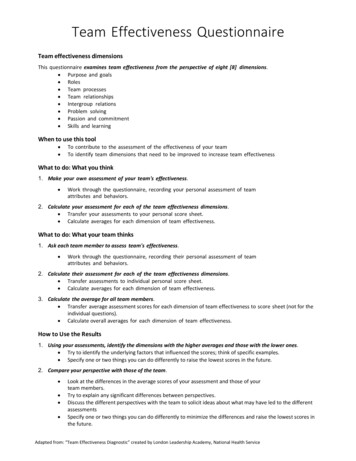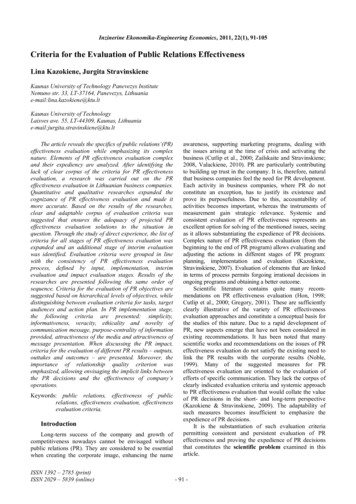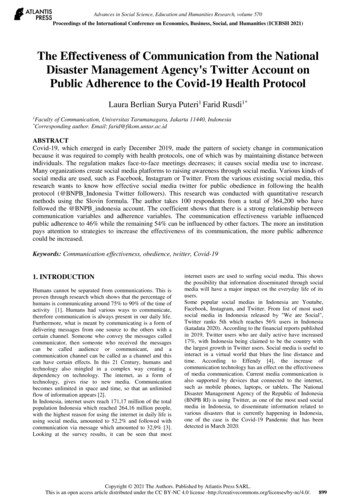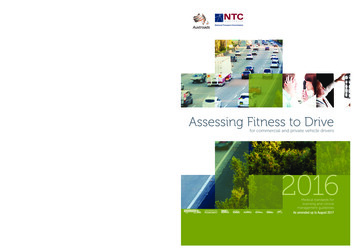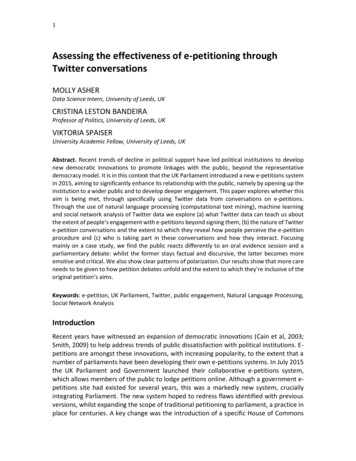
Transcription
1Assessing the effectiveness of e-petitioning throughTwitter conversationsMOLLY ASHERData Science Intern, University of Leeds, UKCRISTINA LESTON BANDEIRAProfessor of Politics, University of Leeds, UKVIKTORIA SPAISERUniversity Academic Fellow, University of Leeds, UKAbstract. Recent trends of decline in political support have led political institutions to developnew democratic innovations to promote linkages with the public, beyond the representativedemocracy model. It is in this context that the UK Parliament introduced a new e-petitions systemin 2015, aiming to significantly enhance its relationship with the public, namely by opening up theinstitution to a wider public and to develop deeper engagement. This paper explores whether thisaim is being met, through specifically using Twitter data from conversations on e-petitions.Through the use of natural language processing (computational text mining), machine learningand social network analysis of Twitter data we explore (a) what Twitter data can teach us aboutthe extent of people’s engagement with e-petitions beyond signing them, (b) the nature of Twittere-petition conversations and the extent to which they reveal how people perceive the e-petitionprocedure and (c) who is taking part in these conversations and how they interact. Focusingmainly on a case study, we find the public reacts differently to an oral evidence session and aparliamentary debate: whilst the former stays factual and discursive, the latter becomes moreemotive and critical. We also show clear patterns of polarization. Our results show that more careneeds to be given to how petition debates unfold and the extent to which they’re inclusive of theoriginal petition’s aims.Keywords: e-petition, UK Parliament, Twitter, public engagement, Natural Language Processing,Social Network AnalysisIntroductionRecent years have witnessed an expansion of democratic innovations (Cain et al, 2003;Smith, 2009) to help address trends of public dissatisfaction with political institutions. Epetitions are amongst these innovations, with increasing popularity, to the extent that anumber of parliaments have been developing their own e-petitions systems. In July 2015the UK Parliament and Government launched their collaborative e-petitions system,which allows members of the public to lodge petitions online. Although a government epetitions site had existed for several years, this was a markedly new system, cruciallyintegrating Parliament. The new system hoped to redress flaws identified with previousversions, whilst expanding the scope of traditional petitioning to parliament, a practice inplace for centuries. A key change was the introduction of a specific House of Commons
2Petitions Committee to oversee the process and to liaise with petitioners. This was inresponse to assertions that the previous, government-led, system was failing to deliveron its promises, and was risking “reputational damage to the House of Commons inparticular, and an exacerbation of public disillusionment with the political system in thelong-term" (Hansard 2012, 5). When the House finally came to report on a new agreed epetitions system, there was much hope that it had “the potential to bring about asignificant enhancement of the relationship between petitioning public and their electedrepresentatives” (Procedure Committee, 2014, 31). Since then, the e-petitions system hasmediated very significant activity, with over 18,000 e-petitions submitted in its first yearalone. Besides this, the Petitions Committee has also developed a plethora of publicengagement activities utilizing a wide range of tools such Twitter, the focus of this paper.However, there has been little attempt made to study whether those interacting with thesystem have felt politically empowered by it and whether it is indeed acting to enhancethe relationship between public and representatives.In this paper we utilise Twitter data to assess this issue. While we acknowledge thatTwitter data is not representative of the view of the general public (Duggan & Brenner2013; Ruths & Pfeffer 2014), it can nevertheless serve as a first, quick, indicative measureof people’s opinions and sentiments particularly when no other, more representative,data is available. In fact social media are increasingly used by media, campaigners,companies and governments to get an idea of what is on peoples’ minds (Ceron et al.2014; Fast et al. 2015; Smith & Derville Gallicano 2015). We explore what Twitterconversations can tell us about the UK Parliament’s1 e-petitions system’s effectiveness inengaging the public. We focus on Twitter data for two reasons: first of all, the PetitionsCommittee explicitly uses Twitter to engage the wider public in the parliamentary debatesof petitions that reach over 100,000 signatures; secondly, Twitter data are per defaultpublic and thus more easily accessible than for instance data from Facebook, which hostsmuch more private, closed groups debates.Our Twitter data relates to conversations on 16 e-petitions that were granted aparliamentary debate between March and November 2016 and it covers 21parliamentary sessions, mostly debates but including also five oral evidence sessions. Wecollated data of tweets using the hashtags determined by the Petitions Committee foreach instance. However, our analysis in this paper focuses primarily on one petition callingfor a ban to driven grouse shooting. This makes an interesting case study for two keyreasons. Firstly, as the practice is fiercely protected by some and strongly opposed, mostlyon environmental and animal rights grounds, by others, it refers to something a specificpublic feels very strongly about, being more likely therefore to engage in discussions. Thispetition did generate very active discussions on Twitter providing for rich data which canusefully be explored to gain deeper insights into how people react to a parliamentarysession addressing a petition they feel strongly about. Secondly, besides a debate, thispetition also led to an oral evidence session, which allows the creator of the petition andother experts to provide evidence. This enables us to compare public reactions to how epetitions are dealt with in parliament between two very different types of parliamentary
3sessions. Despite the focus on this case study, we will also refer to other petition debateson Twitter where applicable. In particular, we will examine the following three questions:1. What can Twitter conversations tell us about the extent to which individualsengage in the petitioning process beyond the signing stage?2. How are individuals engaging through Twitter with e-petitions and to what extentdo their discussions inform us about their reactions to the e-petitions process?3. Who gets involved in Twitter conversations about e-petitions and how do theyinteract?We will proceed by first outlining the theoretical questions that have informed our Twitterdata analyses. We will then explain our data and methodological approach. Following thiswe will present and discuss our results, answering the aforementioned three questionsand then finish the paper with a conclusion.Trust, Public Engagement and the new E-Petitions SystemAs clearly established by a wide range of studies and scholars, the last few decades havewitnessed a general trend of decline of political support in traditional representativedemocracy institutions, in Britain and elsewhere (Dalton, 2004; Franklin, 2004; Stoker,2006; Hay, 2007, Norris, 2011; Whiteley, 2012; Mair, 2013). This is reflected in low levelsof voter turnout and of public trust in political institutions. Simultaneously we have seena rise in popularity of different forms of democracy, namely of participatory democracyinitiatives, and a deepening of public expectations towards more regular involvement inpolitics between elections. If participation in traditional political institutions has declined,engagement through other forms of participation has actually expanded (Cain et al, 2003;Norris, 2011). In particular, Dalton et al (2003) show that faced with perceived rising levelsof disenchantment, political institutions across advanced industrial democracies haveexpanded new mechanisms of linkage with the public, leading to a rise in directdemocracy initiatives such as referendums, but also of advocacy democracy initiatives.Advocacy democracy refers to initiatives whereby “citizens directly participate in theprocess of policy formation or administration, although the final decisions are still madeby elites” (Dalton et al, 2003, 11). Petitions fall into this type of initiatives. And, as withother democratic innovations (Smith, 2009), we have seen a particular rise in thepopularity of e-petitions since the early 2000s, thanks in great part to the opportunitiesbrought by the internet in terms of easiness of dissemination and collation of signatures(Hale et al. 2014). The World Values Survey have shown for some time that petitions areone of the most used tools of political activism (WVS, 2017), a phenomenon confirmed inthe UK by the Hansard Society’s Audits of Political Engagement (Hansard Society, 2016).This expansion happened first mainly through informal e-petitions platforms, such asPetitionOnline and Change.org, but formal political institutions have also started tappinginto this as a way to strengthen linkages with the public. It is within this context that anumber of governments and parliaments have introduced e-petitions systems, such asthe 2015 UK Parliament and Government collaborative e-petitions system.
4Petitions have existed for centuries, in many ways pre-dating representative institutions.They are the simplest form for a citizen to present a concern and/or a request to politicalauthorities. They went into disuse over the last century, as focus shifted to representativeinstitutions such as political parties and legislatures. But they were a highly used tool inpast centuries, namely in the UK from the 17th century to the beginning of 19th century,when thousands of petitions were presented annually with the back-up of millions ofsignatures to Parliament (Leys, 1955; Judge, 1978). Their online form, however, has ledto their resurgence. After the Scottish Parliament launched its own e-petitions system in2004, other parliaments followed such as the German Bundestag in 2005 and mostrecently, in 2016, the Irish Parliament. There is great variance between these systems butthey all hope to provide citizens a channel to present their grievances and suggestionsdirectly to parliament, rather than through mediators such as MPs or parties. They aim toopen the institution to the public and ultimately to promote trust in the institution.However, many questions still arise from the practice of parliamentary e-petitions.Broadly speaking, do they make a difference? Do they actually lead to citizen-led policyand, more importantly for the purposes of this paper, do they lead to deeper engagementwith parliament? In his seminal study of the Scottish Parliament, Carman (2010) showedthat evaluations of procedural fairness are crucial in shaping the extent to which petitionscan enhance trust in parliament. Regardless of the outcome of their petitions, ifpetitioners felt that their petition had been considered through a fair process, their truston parliament rose. Bochel (2016) argues also that procedural fairness is key for theeffectiveness of petitions’ systems. A petitions system can therefore contribute towardsimproved perceptions of parliament, if procedurally sound. It is also hoped that it deepensengagement, in that it encourages citizens to engage with Parliament through the issuesthat matter to them.These were very much the hopes when the UK Parliament’s new e-petitions system wasestablished in 2015. A key difference of the new system lies in the creation of a PetitionsCommittee, which would lead on the moderation, processing and engagement withpetitions. As the then Leader of the House stated, this was “a major change and shouldbe the catalyst for a fundamental change in the relationship between parliament andpetitioner” (Hague, HC Debates 24 February: col.256). After the much criticisedgovernment e-petitions sites, there was a clear intent that the new system wouldencompass fair and transparent processes, as well as plenty of opportunities forengagement with Parliament. As the Chair of the Procedure Committee, which reportedon the details of the new system, stated “The Petitions Committee will seek to improveengagement with petitioners. Often, those submitting and supporting a petition will notget the exact outcome they want, but they will hopefully feel that their concerns havebeen appreciated and heard through constructive engagement with the Committee”(Walker, HC Debates 24 February: col.250). Clarity of process and engagement aretherefore key in the new system.Once accepted, e-petitions submitted to petition.parliament.uk are accessible onlinewhere supporters can sign the petition. Once it gets 10,000 signatures, the governmentis obliged to respond within 21 days. Once it gets to 100,000 signatures, the Petitions
5Committee considers whether to debate it; most are debated, unless their topic has beenrecently debated in Parliament. When petitions are rejected or when the Committeedecides against doing a petition debate, the reasons are outlined on the petition’swebpage. All signatories of petitions receive updates from the Committee for every newaction taken, such as a response from government. On occasions the Committee leadsinquiries and hosts oral evidence sessions, web forums etc. Each petition’s webpage listsall the actions taken and the respective links to transcripts and web streaming of relevantparliamentary sessions. The process is therefore clearly set out and transparent.The new e-petitions system went live in July 2015. On its first day nine petitions weresubmitted and 60,580 signatures were added, and since then the site has continued toattract significant interest. By the end of March 2017, over 10,000 petitions had beensuccessfully submitted and over 10 million unique email addresses had been used to signthem, with several petitions gaining over one million signatures. The first 18 months ofthe system’s life have been largely deemed a success. The latest Audit of PoliticalEngagement reported that e-petitions were the “new front door of parliament” and the“single most important route to engage the public that Parliament currently has at itsdisposal, apart from direct contact with a representative” (Hansard Society 2016, 1, 28).Besides the very high volumes of e-petitions and signatures, the committee has alsodeveloped six enquiries and a wide range of public engagement initiatives (LestonBandeira, 2016).There has been therefore considerable activity; what we know little ofthough is whether it has also led to effective engagement and how the public is reactingto key elements of the process such as the petition debates.However, it is important to distinguish between activity and effectiveness, as Wilsonestablished back in 1999 “more participation is not the same thing as more democracy”(Wilson 1999, 258). Quantifying whether e-petitions are achieving their aims of increasingpolitical engagement and trust of parliament and leading to “more democracy” is acomplex problem, but their existence on a digital platform opens up new possibilities forstudy. E-petitions leave a strong online imprint from their creation, to their presentation,to their dissemination and to their eventual debate (Hale et al. 2013a). Our analysisfocuses on data from conversations on Twitter, collected using a series of hashtagsdefined by the Petitions Committee to promote conversations on petitions. Harvestingthis data allows the creation of a ‘big data’ set containing a traceable log of everyindividual who used the hashtag to interact with the petitions on Twitter and a record ofwhat they actually said (Hale et al. 2013a). This is a shift from conventional social sciencemethods, which rely on surveys of a representative sample of a population and containinformation only on how individuals reported to have behaved (Hale et al. 2013a).Crucially, this data enables us to listen in real-time to what the public is saying whilst apetition parliamentary debate is taking place. In short, it gives us an insight to first-handreactions from a public particularly interested in specific petitions. Considering howimportant procedural fairness is for petitions’ evaluation (Carman, 2010), these Twitterconversations allow us to determine what the public thinks about the unfolding petitiondebate, and/or oral evidence session.
6Signing an e-petition is a small political participation act, intended to be just the beginningof a process of raising the importance of an issue with Government and Parliament.However, there are concerns that the process of signing an e-petition may actually be tooeasy to provide a real hook for engagement (Jungherr & Jurgens 2010). This is reflectedin the description of e-petitions as ‘clicktivism’ or ‘slacktivism’ and “a trivial form ofadvocacy that doesn’t accomplish anything” (Beato 2014, 23). There is a worry that epetitions may even result in fewer individuals taking part in other political or civicactivities as they have satisfied their internal moral obligation for action (Lee & Hsieh2013). Engaging in Twitter conversations around a petition debate and raising awarenessit is taking place is one way engagement can be maintained. Analysis of these Twitterconversations can therefore inform understanding of the extent to which engagement ismaintained beyond signing.Finally, the availability of e-petitions through the Internet is hoped to help broadenengagement to disengaged groups and to provide an ideal platform for political discussion(Dahlgren 2005); this would lead to “more democracy”. Conversely, it could in factaccentuate political fractures in the population (Galston 2003). The concern is that theInternet allows individuals to selectively interact with those who are similar to them(without geographic constraints), therefore providing an echo chamber, which reinforcesprior political views (Colleoni et al. 2014). As Norris established back in 2001, web-basedparticipation may in fact widen the digital democratic divide rather than promote moreengagement. The tendency of individuals to seek out interaction with others who theyperceive as similar to them is known as homophily and can result into fractionalisation ofcitizens into politically polarised, homogenous groups (Hoffman 2012). Homophily hasbeen shown to be found in political conversations on Twitter (Himelboim et al. 2014), itis therefore particularly relevant to explore in the context of conversations about epetitions. Are these Twitter conversations promoting a wider engagement with epetitions, or do they reflect closed discussions between those who were already engagedwith the specific petition?Methodological ApproachDataWe collected Twitter data between March and November 2016 using the TwitterStreaming API, which allowed us to scrape in real time all Tweets made to a hashtagdefined by the House of Commons Petitions Committee to coordinate specific petitionsdiscussions on Twitter.For each petition, and unique hashtag, the data was collected the day before the debateor oral evidence session in Parliament, the day of the debate or oral evidence session andthe day after. Overall, Tweets were collected for 21 parliamentary sessions, including 16debates, four oral evidence sessions and one digital debate. In the digital debate in thecontext of the UK Aid e-petition, people were invited to provide input to the
7parliamentary debate via Twitter two days prior to the parliamentary debate. Althoughthe Twitter Streaming API has a 1% of all public tweets rate limit, this did not prohibit thecollection of all tweets tagged with a specific hashtag, as these tweets make up only asmall amount of overall Twitter activity. The data collected includes all of the following:tweet text, author of the tweet, when it was tweeted and whether it was a retweet ornot, the original author of the tweet, plus further information on Twitter users, includingprofile description, location specification, number of followers etc.Although Twitter data can be seen as a rich data source that provides insights intopeoples’ genuine opinions in fine-grained geographical and temporal contexts, the datahas its limitation (Ruths & Pfeffer 2014). Most importantly, Twitter data is notrepresentative, it is based on self-selection on several levels, in our case data is onlycollected from people who have Internet access, who have a Twitter account2 and whodecided to contribute to the respective hashtag thread. Nevertheless, the data is usefulto assess how people, who have a Twitter account and who are sufficiently interested ina specific petition to participate, engage with the parliamentary debate; particularlybearing in mind this is a tool the Petitions Committee actively uses to promote publicengagement with parliamentary processing of petitions. Using social media we are thuslikely to capture in particular opinions of people who feel strong about a certain issue. Onthe other hand their opinions are important to understand how well the e-petitionssystem works in establishing links between people and the Parliament. They can be likedto large focus groups. If the system alienates those willing to engage then it is probablyeven less likely to encourage the disengaged to getting involved.Twitter data can be also problematic for another reason – social bots. Social bots canfurther distort the data, for instance by simulating support for an issue by retweetingevery tweet tagged with a specific hashtag or by generating a random opinion through asyntactically correct combination of words (Murphy et al. 2016). It is not a trivial task todetect bots in large amounts of data and bot detection is an ongoing and very active areaof research (Davis et al. 2016; Morstatter et al. 2016). We have some evidence in our data(see Supporting Information S2.1) that social bots were used in particular in the#FireworkDebate (e-petition demanding banning fireworks to protect animals fromunnecessary stress), however we did not detect any obvious social bot activities in ourmain case study. But even in the #FireworkDebate case, the bot activity is limited to agroup of bots retweeting every tweet with a designated hashtag to simulate engagementwith the debate, without producing new tweets.Though Twitter data was our main data source, we also utilised the verbatim transcriptsof the oral evidence session and parliamentary debate as an additional data source forour case study (ban of grouse shooting e-petition). These transcripts can be downloadedfrom Hansard Online (https://hansard.parliament.uk/) in txt format. We used the datamainly as a reference for sentiment analyses of the Twitter data (see next section).Methodology
8Twitter data comes in JSON format and needs heavy processing prior to analysis. For eachdebate the tweets were compiled into a corpus and R Natural Language Processing andtext mining tools were used to process and analyse its textual content (see theSupplementary Information S1.1 and S1.2 for further details). The processing involved inparticular tokenizing, thus separating the sentence string into separate words, andstemming, thus determining the stem words, stripping them from their suffixes.Moreover, prior to any analysis, words that are rather poor in meaning on their own, suchas “and”, “in”, are filtered out, because their typical frequency in texts would skew furtheranalyses.When analysing the tweet content we were in particular interested in establishing maintopics that people were talking about in those tweets. To infer the nature of the latenttopics embedded in each collection of tweets a bigram-based semantic network analysiswas carried out (Wang et al. 2007; Drieger 2013). The text was represented as a networkwith the nodes referring to words and the weighted, undirected edges between thesewords indicating a relationship between the words. In the construction of the network,the semantic meaning of the words was discarded and relationships between words wereindicated purely by their structural proximity to one another. This is based on thelinguistic assumption that “words with similar meanings will occur with similar neighboursif enough text material is available” (Schütze & Pedersen 1995). Thus, if two words cooccurred in a tweet with at most three words separating them, then an edge connectedthese two words in the semantic network.Thus the network is based on bigrams, however, in contrast to usual bigram analyses,where two words typically stand in direct proximity, we have decided to increase theproximity window to five (including the two words themselves) because we found thatthis approach generated significantly better results in topic detection. The edges wereweighted by the frequency of the co-occurrence of the two respective words. We usedthe Force Atlas 2 algorithm to structure the semantic network. The algorithm induces thenodes to repel each other like charged particles, whilst the edges attract their nodes likesprings and eventually the network converges to a balanced state (Jacomy et al. 2014).To detect topics, we made use of the Louvian method for community detection (Blondelet al. 2008). The algorithm attempts to optimise the network modularity. Modularitymeasures the density of edges inside communities relative to the density of edges outsidecommunities. In large networks this optimisation has to be achieved through heuristicalgorithms, since it would be impossible to go through all possible combination iteratively.The Louvian method detects first small communities by optimising modularity locally,then these small communities are grouped and the modularity optimization is repeated(Kido et al. 2016). We found that this approach produced better topic detection resultsthan the more common Latent Dirichlet Allocation topic modelling approaches (Hong &Davison 2010) (see the Supplementary Information S1.3 for further details).Additionally, we performed an automatic sentiment analysis to gain an overview of theemotions expressed in the Twitter conversations and to determine whether thediscussions were predominantly negatively or positively framed. For that purpose, the
9corpus was split into individual word tokens and a word frequency table was constructedwhich was then joined to the AFINN-111 online lexicon (Nielsen 2011) containingsentiment words with pre-coded sentiment scores. This lexicon contains 2,477 words andphrases tagged with a score between minus 5 (negative sentiments) and plus 5 (positivesentiments) and was constructed with short texts in mind, such as those found on socialmedia (Nielsen 2011). Scores were extracted for words in the lexicon that matched thewords in our corpus, generating a table with words, their frequency and their sentimentscore. Based on the distribution of negative and positive words the overall valence of theconversation framing can be estimated (see the Supplementary Information S1.4 forfurther details).Since we are also interested in who is getting involved in these Twitter discussions andhow, we not only examined the tweets text, but also their respective Twitter users andretweet patterns. Amongst other things, this enabled us to determine Twitter users whoparticipated in multiple debates. The interactions between Twitter users was analysedthrough the use of networks, in the form of social network analysis (Scott 2013). Adirected edge was defined between two users (nodes) if one had retweeted the other.The edge was weighted by the frequency of retweet interactions in the same direction,i.e. when multiple tweets were retweeted. The Force Atlas 2 algorithm was used tostructure the social networks. Communities in the social network were detected using theLouvian method as described earlier. To determine influential users within the network,social network metrics, such as the in-degree (number of incoming edges), betweennesscentrality (number of times a node acts as a bridge along the shortest path between twoother nodes) and eigenvector centrality were used. Eigenvector centrality evaluates theimportance of a node based upon both how many incoming edges they have from othernodes, and how important the nodes are that they are connected to (Hanneman & Riddle2005). Thus, a retweet by a user who in turn had been retweeted by other users wouldbe valued more highly than a retweet by one who had not. Eigenvector centrality wasused in the visualisation of the social network, i.e. the size of the nodes of users wasproportional to their relative influence in the network (see the SupplementaryInformation S1.5 for further details). For central Twitter users we also extracted fullnames and the profile description from the Twitter data to learn who the users were.Finally, we were interested in understanding to what extent we find polarization patternsin the social networks based on retweets. We used the Naïve Bayes Classifier (NBC)approach to classify Twitter users making use of their profile descriptions. Naïve BayesClassifier is a supervised machine learning technique which uses probabilistic learningmethods based upon Bayes’ theorem assuming independence between the features (inthis case, words) (Han et al. 2012; Murphy 2012). The classifier is “naïve” because of thestrong independence assumption, since we do not expect the features to be realisticallyindependent. Nevertheless, the classifier produces often very good classification results,because of its simplicity, which makes it relative immune to overfitting (ibid). A trainingset was manually constructed containing 200 Twitter users and their profile description(features) tagged with one of the three labels “pro-grouse
We explore what Twitter conversations can tell us about the UK Parliament's1 e-petitions system's effectiveness in engaging the public. We focus on Twitter data for two reasons: first of all, the Petitions Committee explicitly uses Twitter to engage the wider public in the parliamentary debates





